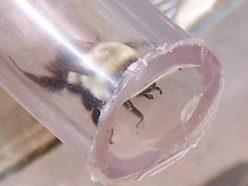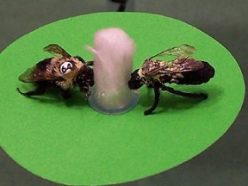Copybees
Bees can learn about new food sources by spying on each other.
By Emily Sohn
Baby brothers and sisters aren’t the only copycats in town. Bumblebees imitate each other, too.
In one study, researchers at Queen Mary University of London put a “demonstrator” bee on a fake flower of a particular color while other bees watched. Afterwards, the observer bees tended to go to fake flowers of the same color. When the scientists put the demonstrator bee on fake flowers of a different color instead, the other bees also often made the switch.
 |
|
A bumblebee inside a plastic tube watches through the porthole as other bees feed on artificial flowers.
|
| Brad Worden |
In another study, researchers from the University of Arizona in Tucson went a step further. The scientists used bees that had been trained to visit either orange or green fake flowers. They also used a group of bees that had never seen these kinds of fake flowers before.
First, the untrained bees sat in a cage and watched for 10 minutes as the trained bees visited one of the two colored flowers. To remove the scent of bees, the scientists then took these flowers away and replaced them with a different set of orange and green fake flowers. And, to prevent the bees from memorizing locations, the scientists arranged the new flowers in a different pattern.
Next, the researchers let loose one test bee at a time. Some test bees had watched the demonstrators. Others had not. Both were equally likely to visit orange flowers. This makes sense because bumblebees often visit orange flowers in the wild.
Test bees were 50 percent more likely to visit green flowers, however, if they had watched other bees do it first.
 |
|
In a setup to test social learning, a bumblebee (left) feeds at a cotton wick soaked with sugar water that sticks out of a green paper flower. The fake bee (right) is positioned to look like a feeding bee.
|
| Brad Worden |
In a similar experiment, the researchers made fake bees and put them on green flowers, while untrained bees watched. The observer bees were twice as likely to visit green flowers after watching the display than they were before watching it. Green flowers are unusual in nature, so bees probably won’t visit them without seeing an example first.
Together, the studies have persuaded researchers that bees can learn new behaviors by watching each other. This kind of social learning is common in people and other vertebrates, but these experiments were the first tests on bees.
Bumblebees, it turns out, notice a lot more than you might think.
Going Deeper:
Milius, Susan. 2005. Bumblebee 007: Bees can spy on others’ flower choices. Science News 168(Sept. 3):150. Available at http://www.sciencenews.org/articles/20050903/fob8.asp .
You can learn more about research on bees and learning at www.eurekalert.org/pub_releases/2005-08/uoa-bsb083105.php (University of Arizona) and www.qmul.ac.uk/news/newsrelease.php?news_id=136 (Queen Mary University of London).







